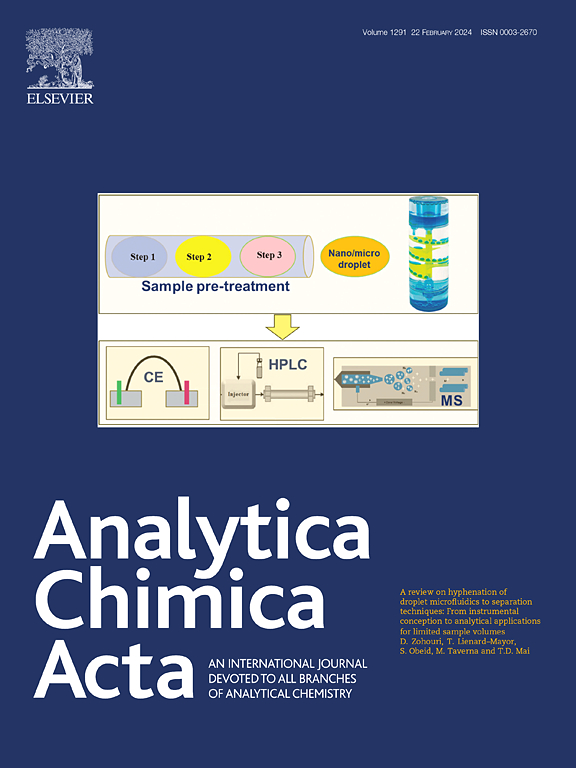AI integration into wavelength-based SPR biosensing: Advancements in spectroscopic analysis and detection
IF 6
2区 化学
Q1 CHEMISTRY, ANALYTICAL
引用次数: 0
Abstract
Background
In recent years, employing deep learning methods in the biosensing area has significantly reduced data analysis time and enhanced data interpretation and prediction accuracy. In some SPR fields, research teams have further enhanced detection capabilities using deep learning techniques. However, the application of deep learning to spectroscopic surface plasmon resonance (SPR) biosensors has not been reported. This study addresses the integration of AI methods to improve the signal-to-noise ratio (SNR) and detection accuracy of wavelength-based portable SPR biosensors.
Results
We designed a deep neural network integrated with the spectral subtraction method to extract SPR responses from the proposed portable SPR biosensor. Using difference spectra as the model input, our AI model provided superior noise reduction and enhanced detection capabilities, outperforming traditional spectral feature extraction methods like dip or centroid positioning. Our study achieved a significantly amplified SNR and improved detection resolution to an impressive 10−7 RIU level. In addition, we employ Shapley Additive Explanations (SHAP) analysis to determine which parts of the input the AI model considers most important when extracting SPR response, thereby increasing the interpretability and transparency of the AI model. The results indicate that the wavelength regions considered most important by our proposed AI model are very close to the full width at half maximum (FWHM) range. This region is also recognized by traditional theory as having a significant impact on the sensitivity of SPR sensing.
Significance
Integrating AI into wavelength-based portable SPR biosensing represents a significant advancement in on-site detection technologies, driving potential applications across various monitoring scenarios. Our findings highlight the AI model's effectiveness in reducing noise and enhancing detection accuracy, particularly in measurements involving low-concentration analytes. This innovation holds great promise for fields that demand real-time, high-precision, on-site detection, such as biomedical diagnostics, environmental monitoring, and biochemical analysis, setting the stage for transformative shifts in these critical areas.


人工智能集成到基于波长的SPR生物传感:光谱分析和检测的进展
近年来,深度学习方法在生物传感领域的应用大大减少了数据分析时间,提高了数据解释和预测精度。在一些SPR领域,研究团队使用深度学习技术进一步增强了检测能力。然而,深度学习在光谱表面等离子体共振(SPR)生物传感器中的应用尚未见报道。本研究旨在整合人工智能方法,提高基于波长的便携式SPR生物传感器的信噪比和检测精度。结果设计了一种结合光谱减法的深度神经网络提取便携式SPR生物传感器的SPR响应。采用差分光谱作为模型输入,我们的人工智能模型提供了卓越的降噪和增强的检测能力,优于传统的光谱特征提取方法,如倾角或质心定位。我们的研究实现了显著放大的信噪比,并将检测分辨率提高到令人印象深刻的10-7 RIU水平。此外,我们采用Shapley加性解释(SHAP)分析来确定人工智能模型在提取SPR响应时认为输入的哪些部分最重要,从而提高了人工智能模型的可解释性和透明度。结果表明,我们提出的人工智能模型所考虑的最重要的波长区域非常接近全宽度半最大值(FWHM)范围。这一区域也被传统理论认为对SPR传感的灵敏度有重大影响。将人工智能集成到基于波长的便携式SPR生物传感中,代表了现场检测技术的重大进步,推动了各种监测场景的潜在应用。我们的研究结果强调了人工智能模型在降低噪音和提高检测精度方面的有效性,特别是在涉及低浓度分析物的测量中。这一创新为需要实时、高精度、现场检测的领域带来了巨大的希望,如生物医学诊断、环境监测和生化分析,为这些关键领域的变革奠定了基础。
本文章由计算机程序翻译,如有差异,请以英文原文为准。
求助全文
约1分钟内获得全文
求助全文
来源期刊

Analytica Chimica Acta
化学-分析化学
CiteScore
10.40
自引率
6.50%
发文量
1081
审稿时长
38 days
期刊介绍:
Analytica Chimica Acta has an open access mirror journal Analytica Chimica Acta: X, sharing the same aims and scope, editorial team, submission system and rigorous peer review.
Analytica Chimica Acta provides a forum for the rapid publication of original research, and critical, comprehensive reviews dealing with all aspects of fundamental and applied modern analytical chemistry. The journal welcomes the submission of research papers which report studies concerning the development of new and significant analytical methodologies. In determining the suitability of submitted articles for publication, particular scrutiny will be placed on the degree of novelty and impact of the research and the extent to which it adds to the existing body of knowledge in analytical chemistry.
 求助内容:
求助内容: 应助结果提醒方式:
应助结果提醒方式:


